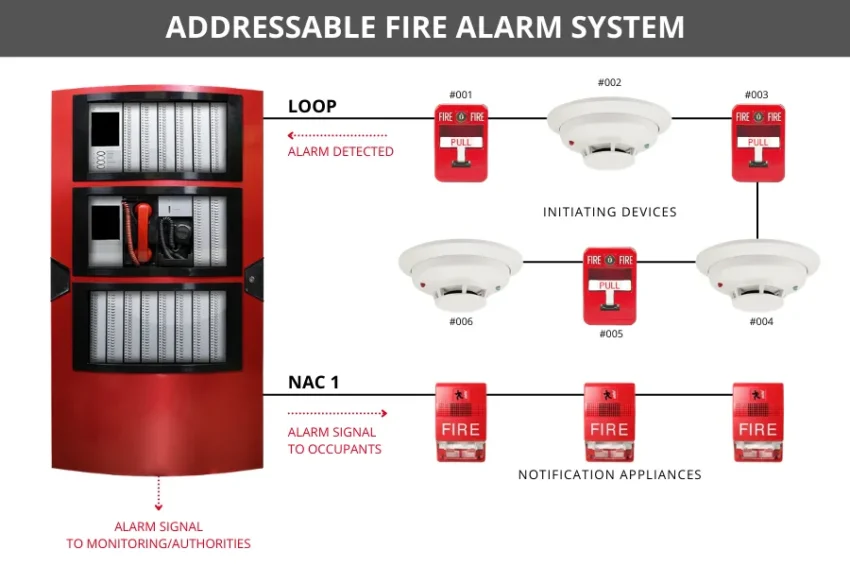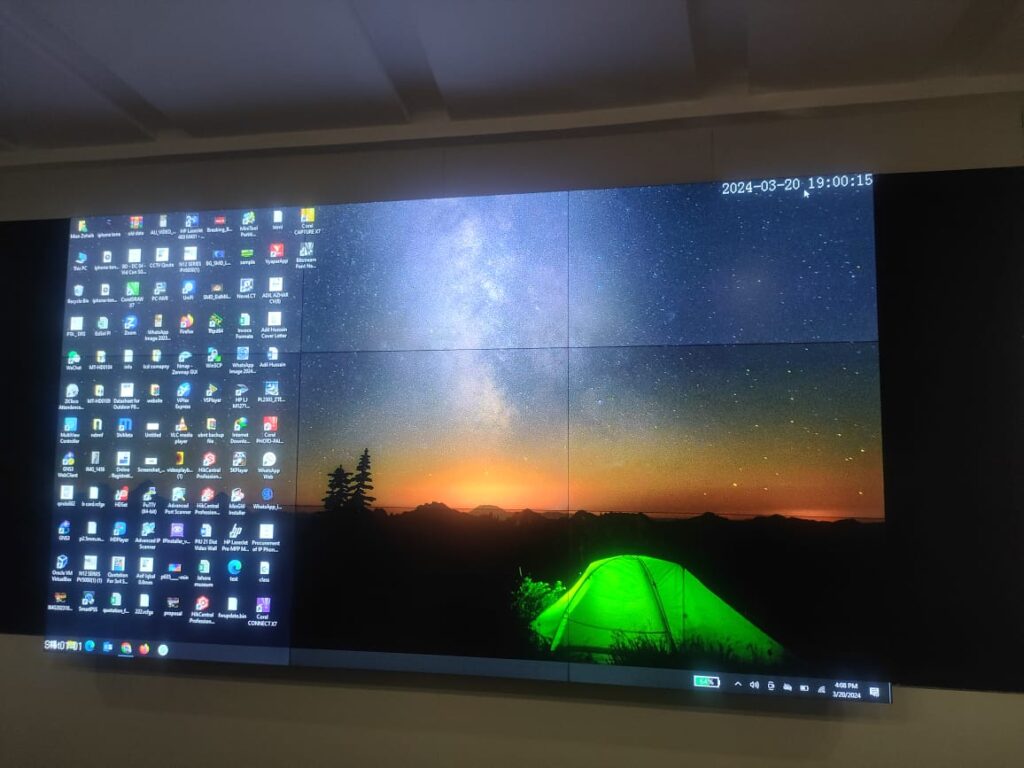Fire alarm systems are a critical part of keeping homes and businesses safe. They do more than just sound an alert. Modern systems detect smoke, heat, or fire, notify occupants immediately, and can even connect to emergency services for rapid response.
In this guide, you will learn step-by-step how to install a fire alarm system in 2025 including smoke detector placement, wiring, programming, and compliance with safety codes. We will also cover commercial and residential setups, common mistakes to avoid, and cost considerations, so you can make informed decisions whether you are a DIY homeowner or hiring a professional fire alarm installer.
What Is a Fire Alarm System?
A fire alarm system is a network of devices designed to detect fire, smoke, or carbon monoxide and alert both building occupants and emergency responders. Its main goal is early warning so people can evacuate safely and help can arrive quickly.
Typical components include smoke and heat detectors, manual pull stations, and visual/audio alarms, all connected to a central fire alarm control panel. Some systems may also disable elevators during an emergency to improve safety. Fire alarms are required in most commercial buildings, and installing them correctly ensures your system works effectively when it’s needed most.
Key Steps to Install a Fire Alarm System
Step 1: Start by identifying zones that are more prone to fire hazards such as kitchens, basements, electrical rooms, and hallways. Note down the ceiling heights, floor levels, and airflow patterns. This helps in deciding the optimal placement for each detector and alarm device to ensure complete coverage.
Step 2: Mount smoke detectors on the ceiling, ideally at the center of the room and away from walls, windows, or vents where airflow could affect detection. Avoid areas with excess steam or dust like bathrooms or workshops. Make sure every floor, including attics and basements, has adequate detector coverage.
Step 3: Place the control panel in an accessible, secure location with primary power and battery backup.
Step 4: Choose an accessible yet secure location for the control panel preferably near the main entrance or maintenance area. Ensure it has a dedicated power supply and a battery backup so the system stays functional during power outages.
Step 5: For wired systems, connect all detectors and devices according to the zoning layout provided in the installation manual. For wireless systems, mount each unit and sync it with the control panel using the pairing instructions. Label zones for easy identification during maintenance or alerts.
Step 6: Attach horns, sirens, and strobe lights in visible and audible locations across the property. These devices should be loud and bright enough to alert all occupants. Once installed, test each notification device to confirm proper operation and synchronization with the control panel.
Step 7: Program the zones and device addresses on the control panel. Then, perform a comprehensive test to trigger each detector and verify that alarms, strobes, and the panel respond correctly. Document the results and make any necessary adjustments for full compliance and reliability.
Smoke Detector Installation and Placement Guide
Correct placement of smoke detectors is essential for fast and reliable fire detection. Always install detectors on the ceiling, where smoke naturally rises, and keep them at least 10–12 inches away from walls or corners to ensure proper airflow.
Avoid areas like kitchens, bathrooms, or near air vents, as steam or smoke can trigger false alarms. Each floor of your building,including basements and attics. Should have at least one detector. For bedrooms and sleeping areas, place detectors close enough for the alarm to be heard clearly, providing early warning and maximum protection when it matters most.
Commercial Fire Alarm Installation Requirements
Installing a fire alarm system in commercial spaces such as offices, retail stores, and industrial sites demands strict adherence to safety standards. These systems must be capable of quickly detecting fires, alerting occupants, and notifying emergency services for rapid response.
All installations should follow fire brigade-approved protocols, ensuring that equipment type, placement, and wiring meet the latest safety regulations. Commercial systems often require 24/7 fire alarm monitoring, typically connected through dedicated telephone or IP lines for immediate communication with emergency responders.
Additionally, compliance with local fire and building codes is mandatory. This includes ensuring proper detector coverage, clear evacuation signals, and regular inspection or maintenance schedules to keep the system reliable and up to code.
Common Installation Mistakes to Avoid
Even the best fire alarm systems can fail if installed incorrectly. Being aware of common mistakes helps ensure safety and reliability.
Improper Placement of Detectors
Installing detectors near drafty areas like doors, windows, or air ducts can trigger false alarms. Detectors placed too close to kitchens or cooking appliances may also cause frequent nuisance alerts. Always position detectors strategically to monitor fire signs effectively without interference from environmental factors.
Inadequate System Design
Systems that do not account for the building layout or occupancy can leave areas unmonitored. Lack of scalability for future changes can make upgrades costly and limit protection. A proper design ensures comprehensive coverage now and in the future.
Non-Compliance
Using non-listed or incompatible equipment or ignoring local fire safety regulations can compromise system performance and safety, and lead to legal issues. Always follow relevant codes and standards
Poor Wiring
Faulty connections or unprotected wiring can cause malfunctions, false alarms, or total system failure. Proper wiring and protection are crucial for reliability.
Neglecting Maintenance
Skipping routine maintenance or irregular system testing can allow issues to go unnoticed, reducing system effectiveness. Regular inspections and tests ensure your fire alarm system works when it’s needed most.
Fire Alarm System Installation cost
The cost to install a fire alarm system varies depending on the size of the building, the type of system, and whether it’s residential or commercial. Residential installations, such as a simple smoke detector system, are generally more affordable, while commercial setups with multiple zones, control panels, and monitoring features cost more due to complexity and compliance requirements.
DIY vs Professional Fire Alarm Installation
When it comes to fire alarm installation, both DIY and professional options have their place. For smaller residential setups, a DIY installation might seem cost-effective, especially with modern wireless systems that are easy to mount and configure. However, incorrect placement or wiring mistakes can affect system reliability and delay emergency response.
Professional fire alarm installation ensures every component from detectors to control panels meets code requirements and operates as intended. Certified installers also test, program, and document the system properly, giving you confidence that it will perform during an emergency. For businesses and multi-story buildings, hiring professionals is always the safer, more compliant choice.
Conclusion
Installing a fire alarm system is not just about meeting safety codes. It’s about protecting lives and property. No matter if it is a home, office, or industrial space, ezisol properly designed and maintained alarm system offers peace of mind and early warning in case of fire. While small setups can be handled with DIY care, commercial and large-scale installations should always be managed by certified professionals to ensure full compliance and reliability. Regular testing, maintenance, and timely upgrades keep your system ready when it matters most, helping you stay safe, secure, and compliant all year round.
Frequently Asked Questions (FAQs)
How to install a fire alarm system in a house or apartment?
Start by planning detector placement on every level, including bedrooms and hallways. Mount smoke alarms on ceilings away from vents and windows, connect to power (wired or battery), and test to ensure proper function.
How to replace a smoke alarm safely?
Turn off the power supply, remove the old detector, disconnect its wiring or battery, and install the new unit using the same mounting base or bracket. Always test the alarm after replacement.
What are the most common fire alarm system requirements?
Requirements vary by location but generally include alarms on every floor, inside bedrooms, and near escape routes. Commercial buildings must also comply with NFPA and local fire safety codes.
How often should I test my smoke detector?
Test each smoke alarm at least once a month and replace batteries twice a year. Full system inspections are recommended annually for commercial properties.
Can I install commercial fire alarm systems myself?
It’s best to hire certified fire alarm installers. Commercial systems involve wiring, zoning, and code compliance that require professional knowledge and approval from local authorities.




